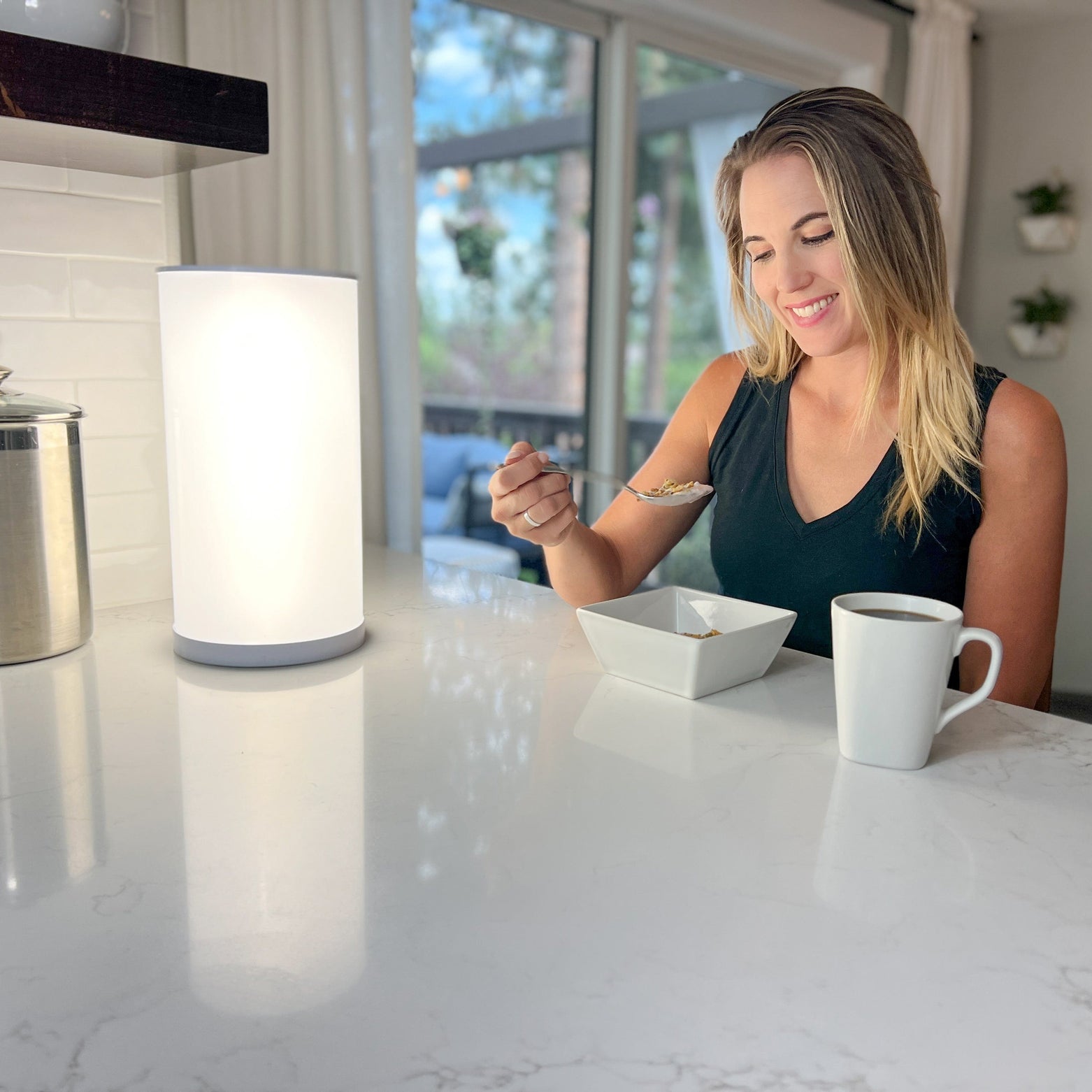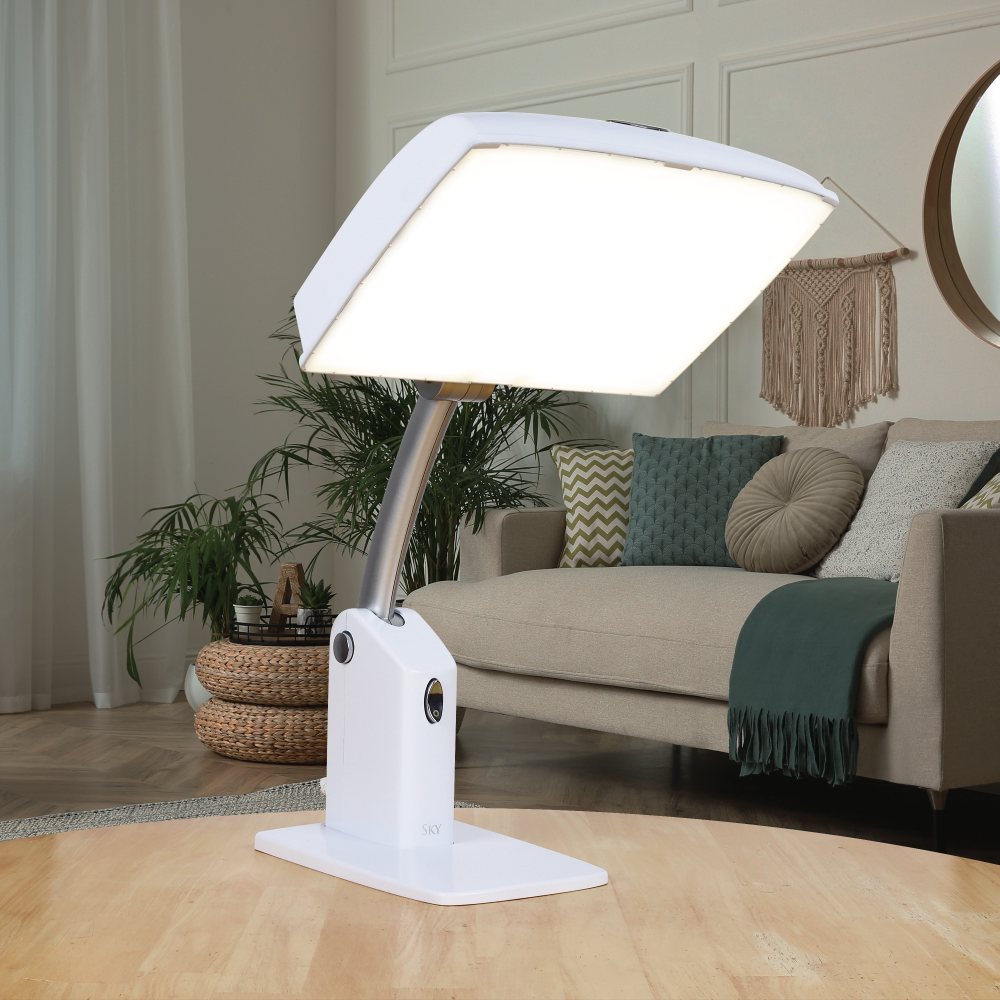Light therapy involves exposure to a specific light intensity and color spectrum to mimic exposure to natural sunlight. Humans need natural sunlight to produce adequate amounts of certain neurotransmitters and hormones, including serotonin and melatonin.
Certain conditions, such as working nights and sleeping in the day, traveling across time zones, and decreased hours of sunlight during the winter, may reduce sun exposure. This reduced sun exposure may affect how much serotonin and melatonin are produced.
If the light from a light therapy lamp is the right intensity and color spectrum, the effects are similar to natural sunlight exposure, which includes the production of melatonin and serotonin.
Light therapy has gained popularity in recent years, especially since the COVID-19 pandemic. During the COVID pandemic, lockdowns changed daily life, social activities, and even how much time people spent outdoors. The lockdowns may also have inadvertently led to isolation and increases in depression. This combination may have sparked an interest in the benefits of light therapy in some people, which may explain in part why it has gained popularity.
The article below covers the benefits of light therapy lamps, including both physical and mental health benefits.
Physical Benefits
There are several physical benefits that light therapy provides, including the following:
Increased energy
Studies have indicated that exposure to bright light increases alertness and energy. The exact reason why bright light exposure may improve energy and alertness is not entirely clear. However, it may be because bright light exposure increases serotonin levels. A deficiency in serotonin may lead to problems sleeping and depression, which can contribute to low energy. Increasing serotonin may have a positive effect on energy levels.
Regulated sleep
Exposure to bright light therapy may help regulate sleep. This study involved 12 students who worked in an office and spent most of their time indoors. The study participants were exposed to regular office light for one week.
After a week break, the students were then exposed to a bright light therapy lamp for 1.5 hours daily for 1 week. Students self-reported and earlier sleep onset time and lower morning sleepiness after exposure to the bright light. No such improvement was found after exposure to regular office lights. Sleep regulation may occur due to the increased production of serotonin.
Increased sexual function
One surprising benefit of bright light therapy may include increased sexual function. One study
involved 24 male subjects with a diagnosis of primary sexual arousal disorder or hypoactive sexual desire disorder. The participants were divided into two groups. One group received bright light therapy. The other group received placebo light therapy.
Study participants were assessed before bright light therapy started and assessed two weeks after therapy ended. After 2 weeks, the group treated with bright light therapy showed a significant improvement in their sexual satisfaction. They self-rated their satisfaction three times higher than the group that received the placebo light.
The exact reason why exposure to bright light may increase sexual function is still being researched. However, it may be due to a complex physiological reaction involving the effect of light and dark on the pineal gland in the brain and the production and release of melatonin.
Regulated digestion and appetite
Light therapy benefits may also include regulated digestion and appetite.
Light therapy helps promote serotonin production. Adequate amounts of serotonin help increase gastric emptying, intestinal secretion, and gut motility, which play important roles in digestion. Without adequate serotonin levels, these functions may be impaired.
Light therapy may also affect appetite, which in turn may affect weight loss. This placebo-controlled randomized clinical trial involved 34 overweight women between the ages of 20 and 54. Measurements were taken at baseline, including body weight, percentage of body fat, and subjective scores for energy levels, mood, and appetite.
The participants were divided into two groups. One group received three weeks of in-home sessions of morning light therapy using a bright light therapy device. The other group received three weeks of placebo treatment using a deactivated ion generator.
Although weight was not significantly reduced compared to the placebo group, fat mass, body fat percentage, and appetite were significantly decreased.
Quicker and more efficient healing
Serotonin is an important hormone that does more than affect your mood. The platelets in your blood store serotonin. When your body needs to heal and repair damage the platelets release serotonin, which promotes wound healing and stops bleeding.
If serotonin is low, it may impede healing. Exposure to light through a light therapy lamp promotes the production of serotonin and therefore may help promote healing.
Reduced blood pressure
The relationship between blood pressure and exposure to bright light therapy continues to be researched.
However, there are research articles that discuss the harmful effects of sleep deprivation in shift workers. For instance, shift workers are often chronically sleep deprived, which leads to sustained elevated cortisol and adrenaline levels; this creates a widespread stress response that can increase heart rate and blood pressure. Treating sleep deprivation through exposure to bright light therapy to regulate melatonin levels may indirectly have a positive effect on blood pressure.
In addition, mental health problems, such as depression and anxiety, may cause blood pressure to increase. Treating these conditions effectively with bright light therapy may also help an individual maintain a healthy blood pressure level.
Creates a well-lit environment
Light therapy lamps also are a great way to light up a room. Keeping your work environment or home well-lit is useful for your overall well-being. Having a well-lit environment helps regulate an efficient sleep-wake cycle.
Additional benefits of creating a well-lit environment include:
- Reducing the risk of falls
- Decreasing fatigue
- Making it easier to see
- Promoting overall mental well-being
Safe and drug-free
It is common to treat conditions, such as circadian rhythm disorders, anxiety, and depression, with medications. In some cases, medications can be helpful. However, medications have side effects, and they can have long-term adverse effects. Additionally, medications used to treat anxiety and sleep problems can become habit-forming.
Light therapy is a drug-free option. It is also safe, has no long-term harmful effects, and has few to no side effects.
Even in instances where medication is still necessary, the use of light therapy may allow for a reduced drug dose, which may decrease the possibility of side effects.
Mental Health and Condition-Based Benefits
Light therapy lamps also have several mental health benefits, such as the following:
Improved memory
According to the Sleep Foundation, individuals who do not get enough sleep may have difficulty remembering things. Sufficient sleep is needed to create new pathways for the information you learned. This process is hindered when you do not get enough sleep. Exposure to bright light may help improve sleep disorders, such as jet lag and insomnia, which may help memory.
An article in Scientific Reports references several studies that have confirmed that retinal light exposure activates the hippocampus, which is associated with memory function. Retinal light exposure can come from direct sunlight. However, exposure to sunlight also exposes an individual to the harmful effects of ultraviolet light rays. Retinal light exposure can also be achieved through bright light therapy.
Enhanced ability to learn
Many conditions related to a decrease in serotonin, such as non-seasonal depression and seasonal affective disorder, affect a person's motivation and concentration, which in turn affects a person's ability to learn.
Although there are no specific studies related to bright light therapy and the ability to learn, it makes sense that improving sleep and symptoms of seasonal depression may promote and enhance a person's ability to learn.
Improving serotonin levels through exposure to bright light has a domino effect. Serotonin levels improve, leading to decreased symptoms of depression, which enhances a person's ability to learn.
Boosted productivity and focus
Conditions related to low serotonin levels, such as seasonal affective disorder, may have a negative effect on concentration, focus, and productivity.
According to the Mayo Clinic, common symptoms of seasonal affective disorder include feeling sluggish, having low energy, and having trouble concentrating. Treating these symptoms can help improve focus, which often boosts productivity.
“I've been using the therapy lamp each morning for a few weeks and feel better. I have more motivation and energy than I did a month ago. I wish I had done it sooner.” Mary- Day light classic plus light therapy review
Helps treat depression and SAD
There is significant evidence that exposure to bright light therapy helps treat seasonal affective disorder (SAD) and non-seasonal depression.
Exposure to bright light at an appropriate intensity tricks the brain into thinking it's being exposed to sunlight. Sunlight helps promote the production of Serotonin, which plays a role in mood.
This 2024 meta-analysis reviewed a total of 21 randomized controlled trials, which involved 1,037 participants with SAD.
Research indicated that bright light therapy is a promising first line non-pharmaceutical treatment for SAD. Study participants showed significant improvement in mood symptoms compared to placebo.
“My therapist gave me a light therapy lamp about 2 months ago to help me with my seasonal affective disorder. Since I started using it my mood improved significantly. Within the first days, I noticed whenever I sat down in front of it in the morning, I immediately get a burst of energy from it.” Lyosiscer- Online forum
Reduced anxiety
SAD lamp benefits may also include reduced anxiety. When neurotransmitters in the brain, such as serotonin and melatonin, are not at sufficient levels, it can have an adverse effect on overall mental health. For example, sleep problems, such as insomnia, and both seasonal depression and non-seasonal depression may also have an anxiety component. Treating those conditions with bright light may help reduce symptoms of anxiety.
“It's like basking on a sunny beach - bright, invigorating, and instantly mood-boosting.” Jakari - Day light classic plus light therapy review
Dementia
According to the Alzheimer's Society, people with dementia often have problems sleeping. This stems from changes to their brain from the disease.
Bright light therapy may be effective in treating sleep disturbances in people with dementia who are in a mild to moderate stage of their condition, and who have a shorter duration of the disease.
Helps treat jet lag
Jet lag is a sleep disorder that occurs when a person's internal circadian rhythm clock does not match the time zone they are in. It can commonly occur when traveling across different time zones. Bright light therapy has shown to be an effective treatment to reset an individual's internal circadian clock.
For instance, this study on light therapy and jet lag found that light therapy created an advance or delay in circadian rhythms. This helped prevent symptoms of jet lag by resetting circadian rhythms to match the time zone an individual was in.
Conclusion
Benefits of light therapy go far beyond improving sleep quality. Light therapy has several benefits. It can be used as a safe and effective way to treat mood disorders, such as seasonal affective disorder and non-seasonal depression.
It is also shown to be an effective treatment for certain sleep disorders, such as circadian rhythm disorders. By treating these conditions, it can also have several other benefits, such as improved memory, regulated digestion, and faster healing.
Before choosing and starting light therapy, it is important to consult a healthcare professional. Certain supplements and medications, along with certain medical conditions, may affect your response to sunlight and possibly light therapy. Advice from a healthcare professional will help you select the most appropriate light for your needs.








Leave a comment
All comments are moderated before being published.
This site is protected by hCaptcha and the hCaptcha Privacy Policy and Terms of Service apply.